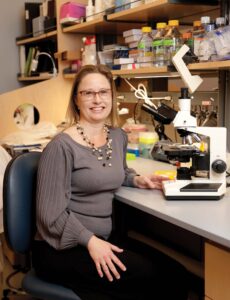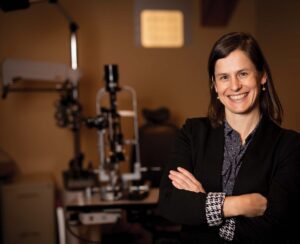A ‘Site” for Sore Eyes

Four years ago, Roger Lasater went outside to look at the stars and the moon.
“They just disappeared,” he said.
Lasater, 78, of Ashland City, Tennessee, was in the beginning stages of age-related macular degeneration (AMD), a chronic eye disease that affects the part of the retina (macula) responsible for central vision. As the name implies, the disease is one of the most common causes of vision loss in older adults. It typically causes blurred or distorted vision or a blind spot in the center of the visual field.
AMD is one of several eye diseases affecting aging adults being treated and studied by physician-scientists at the Vanderbilt Eye Institute (VEI).
“As a leading academic center, we are at the forefront of the use of many new medications we can offer our patients with eye disease, and we are involved in clinical trials to demonstrate better treatment effects and methods for patients and to minimize treatment burden,” said Edward Chaum, MD, PhD, professor of Ophthalmology and Visual Sciences and holder of the Margy Ann and J. Donald M. Gass Chair in Ophthalmology.
Worsening vision
A former sheriff in San Juan County, New Mexico, Lasater said he was known for his laser vision. “The deputies would say, ‘My God, Roger. We don’t know how in the world you can read those license plates at this distance,’” he said. “I went from eyes that could see 1,000 yards off to not being able to see out of one at all, and the other one gradually going bad. But I was blessed with good eyes up until now.”
Lasater said instead of twinkling stars and a yellow moon against a dark sky, a cloud covered the central vision in his right eye.
He rapidly went completely blind in his right eye, recovered some of his peripheral vision after injections, then the cloud moved to his left eye about a year ago. He can still see out of his left eye, but when both eyes were affected, he had to quit driving.
Lasater has been taking care of his wife, who has health issues, for more than six years. They moved to Tennessee in 2019, to be near Vanderbilt and her health care team. His vision problems began shortly after they moved, on their wedding anniversary. “That’s when my eye went to heck,” he said.
“The reason I quit driving is that when I was meeting cars, and they had their daylight running lights on, every car looked distorted. They looked like they had been in a front-end accident,” Lasater recalls. “Now my wife has to drive, and Lord have mercy, she just hasn’t done it in so long. Giving up driving has been the worst thing because of my wife’s medical condition,” he said.

After seeing several ophthalmologists in the Nashville area, Lasater found Chaum, who specializes in the treatment of retinal diseases, including macular degeneration. The retina allows you to see figures and shapes right in front of you; the macula allows you to see details.
“When you’re looking directly at someone or something, you’re using your macula,” said Tonia Rex, PhD, professor of Ophthalmology and Visual Sciences and VEI’s associate director for Research. “If you’re enjoying beautiful colors out in the garden, you’re using the cone photoreceptors in the macula. If you lose the cells there, if they aren’t working properly or they die, it can be particularly devastating because it’s affecting your central vision,” said Rex, who holds the Marlene and Spencer Hays Directorship in Translational Vision Research.
There are two forms of AMD: dry, the more common form, which occurs in about 90% of all cases; and wet, occurring in the other 10%. The condition is more common in Caucasians and in women, and smoking increases the risk, particularly of developing wet AMD.
“I can look at something or someone’s face, and it disappears because the macula has deteriorated,” said Lasater, who has wet AMD. “I can look at a straight line, and it’s not straight. It’s wiggly. But you kind of get used to it,” he said.
Treatments
To help control his AMD, Lasater takes an eye health multivitamin, AREDS II, that contains vitamin E, copper, zinc, lutein and zeaxanthin.
“We don’t have much in the way of treatment for the dry form of AMD; what we have is a multivitamin formulation that’s available over the counter that’s been shown to slow the progression slightly in patients with moderate to severe disease,” Chaum said. “It doesn’t really help patients with mild disease.”
Dry AMD occurs when tiny protein deposits (drusen) damage the macula. Wet AMD occurs when abnormal blood vessels grow under the retina and cause swelling and bleeding.
Dry AMD may not affect the vision at all, or it can cause a loss of central vision. It can be controlled with lifestyle changes including diet and vitamins. It usually develops in stages. In the early stage, it’s only detected during an eye exam. In the intermediate stage, vision can become blurry. In the advanced stage, vision can be lost.
“Most patients with dry AMD have a slow, progressive decline in visual function and visual quality over a period of years,” said Chaum, who is investigating the pathology of dry AMD, particularly the role of autophagy (the body’s cellular recycling system) in the retinal pigment epithelium (RPE). The RPE is the pigmented cell layer just outside the neurosensory retina that nourishes retinal visual cells. Dysfunction of the RPE occurs in AMD.
The FDA recently approved a new injectable drug, Syfovre, to slow the progression of severe dry AMD. A pilot study led by Avni Finn, MD, MBA, assistant professor of Ophthalmology and Visual Sciences, recently began at VEI to look at Syfovre’s safety and efficacy in patients. A similar drug, Vabysmo, was approved for wet AMD in 2022.
Everybody who has wet AMD gets it on top of having dry AMD. “Dry sets the stage for the complication of having wet disease,” Chaum said.
Wet AMD is always considered to be in the advanced stage. It needs consistent treatment with injectable medications that can stop or reverse vision loss. It develops because the retina is making a hormone called vascular endothelial growth factor (VEGF), which stimulates the growth of the abnormal blood vessels in wet disease. Anti-VEGF injections block the effect of VEGF to induce the growth of abnormal blood vessels. The drug “has fundamentally changed the visual outcome in people with the wet disease,” Chaum said. It works by changing the amount of blood that gets to the retina.
Chaum injects Lasater’s right eye monthly with aflibercept, and he has regained some of the peripheral vision in that eye. Once the macular degeneration occurred in his left eye, it was injected every six weeks.
“Twenty years ago, all of these patients went blind,” Chaum said. “We had nothing to treat them. Today, many of them are able to preserve good vision, and even if they’ve lost vision from wet disease, most of them regain some of it because of the drugs.”
Chaum said although the injections are beneficial, and it’s the mainstay of therapy at this time, it’s still a difficult treatment because the eye has to be numbed before it’s injected, and patients have to return every four to 12 weeks for more injections depending on the severity of the disease.
“Our goal is to try to figure out a better way to extend the treatment efficacy so patients don’t have to see us for injections as often as every month,” Chaum said.
VEI is participating in the PULSAR trial aimed to assess the efficacy of high-dose aflibercept in patients with wet AMD.
“We are studying to see whether higher doses of these approved medications can give us a longer lasting effect,” he said.
The silent thief of sight
Nashville resident Jeff Hawley first noticed some vision loss in 2018. He wondered if the LASIK surgery he had a decade before needed tweaking. It turned out he was in the beginning stages of developing glaucoma, which, if untreated, would cause gradual vision loss.

Glaucoma, a progressive neurodegenerative disease that damages the optic nerve — the nerve that connects the eye to the brain — is called the “silent thief of sight” because symptoms don’t normally develop until late in the disease. Glaucoma is a group of optic neuropathies characterized by the death of retinal ganglion cells that are responsible for transmitting signals from the retina to the brain.
It’s slowly progressive, often with pressure building up inside the eye and damaging the optic nerve. Unlike macular degeneration, which takes away central vision, glaucoma impacts peripheral vision first, which makes it difficult to detect.
Hawley, who owns a pest control business with offices in three cities, went through about eight eye specialists before ending up with VEI’s Sylvia Groth, MD, associate professor of Ophthalmology and Visual Sciences, in summer 2019.
“Glaucoma can feel asymptomatic for so long,” Groth said. “The pattern is normally that it progresses in from the nasal side of vision, and we have another eye that can cover from the other direction,” she said. “Having two eyes is a wonderful thing, because it compensates for the loss of vision in our daily life, but it also makes vision loss harder to detect unless someone is monitoring your vision.”
Hawley, who has two types of glaucoma, was in “critical mode” by the time he found Groth. “I had lost most of my vision in my left eye, and my right eye was definitely having some problems,” he said.
Glaucoma, normally occurring in older adults, has a strong genetic predisposition, meaning it can occur in younger individuals with family histories of glaucoma, Groth said. “It’s not completely uncommon to have someone at age 40, particularly African Americans, develop severe glaucoma.”
The disease is most commonly treated with eye drops, although there is a noninvasive laser procedure that can successfully control glaucoma in early stages by trying to coax the eye to drain more fluid without needing daily eye drops. Glaucoma, in later stages, often requires surgery. Untreated, it results in blindness.

“Whether it’s by eye drops or surgeries, the goal of the clinician is to lower the level of intraocular pressure and slow the neurodegeneration,” said Rex, a visual system neuroscientist with training in retinal gene therapy. She is currently investigating how oxidative stress contributes to the progression of neurodegenerative eye diseases. “None of our current approaches stop the progression. They simply slow it,” she said.
In November 2018, due to the glaucoma’s severity, Groth performed a trabeculectomy surgery on Hawley’s left eye, a procedure to allow more fluid to drain out of the eye to slow down the progression of glaucomatous vision loss. A few months later, he underwent surgery on his right eye.
“It really did slow the progression,” he said, adding that Groth is “the most positive, forward-thinking person I know. She is awesome.”
Rex’s lab has identified that the retina mounts a protective response to elevated pressure in the eye, which may be contributing to why glaucoma is such a slow-progressing disease. “Otherwise, after you get an elevated pressure why don’t you start losing your vision right away? Why does it take so many years?” she asked. “We think this molecular pathway, this protective response, is contributing to this slower progression of disease and has also given us targets for therapy.”
While medication and surgery are bedrocks of glaucoma treatment, there is a movement in the field to treat glaucoma earlier with noninvasive laser treatment, specifically selective laser trabeculoplasty (SLT). Investigators from the U.S., including VEI, and the United Kingdom have joined with the National Eye Institute to investigate the optimal energy level and frequency of laser therapy to treat glaucoma.
The COAST study (Clarifying the Optimal Application of SLT Therapy), led at VEI by Rachel Kuchtey, MD, PhD, professor of Ophthalmology and Visual Sciences, is looking at the procedure used for newly diagnosed patients with glaucoma or ocular hypertension. It’s been a treatment option for nearly 20 years, but few studies have specifically compared multiple energy levels. The belief is that low energy SLT may help people avoid the need for eye drop medications for a longer time than standard SLT. There are currently 217 subjects enrolled across 25 sites.

“It’s a big goal to decrease the burden of eye drops for patients because they are easy to forget, and it’s easy to not want to do them or to not tolerate them. That leads to noncompliance for various reasons and to high pressure and the progression of glaucoma,” Groth said, adding that some patients may need to apply eye drops from multiple medications twice a day.
VEI is also a site for the Triton study, led by Jeffrey Kammer, MD, associate professor of Ophthalmology and Visual Sciences, and Crystal Nicholson. The study compares daily eye drops versus a new injectable slow-release implant of the drug bimatoprost for high eye pressure. Instead of having to put in an eye drop each day, a small pellet is inserted into the front of the eye that slowly releases the medication over months. The study is investigating how long each pellet will last since the medication is only FDA-approved for a single injection. Thirteen patients are currently enrolled. “With glaucoma being a lifetime condition, we clearly need treatment more than just once,” Groth said.
In another study, the ARGOS clinical trial, Kammer and Nicholson will examine the long-term effect on eye pressure and safety of the bimatoprost implant in routine practice in patients with glaucoma or hypertension of the eye. Nine patients are currently enrolled.
Learning to adapt
Although Hawley can no longer drive, and his mobility has been impacted, he has learned to adapt. He still has some vision in his right eye and chooses to look at his life as a glass half full.
He cannot drive, but he can get his wife, Jennifer, to take him where he needs to go, or he can call an Uber. He cannot read books, but he can listen to them using Audible. He cannot go for a run, but he can carefully navigate a walk in his neighborhood.
Hawley said he is surrounded by “a lot of good people,” and with the help of his wife and friends, he can do much of what he used to. He tries to attend a Titans game once a year but must buy seats near the jumbotron to watch the action. He also tries to go to a movie every now and then. “I still make myself do it, because I know if I don’t, I can go down a bad path pretty quickly,” he said.
He didn’t let his poor vision keep him from experiencing the Sistine Chapel in Rome on a recent vacation with Jennifer.
“I don’t see depths at all, and when you come out of the Sistine Chapel, there are probably 100 steps you have to walk down. I couldn’t tell one step from the next. There were no yellow safety lines on the steps. It looked just like a ramp to me. My wife held on to me, and said, ‘step down, step down, step down’ the whole way.
“I’m just very grateful, very thankful that everything went according to plan as far as what we could control,” Hawley said. “I just have to be careful if I go out, looking for curbs and going slow. I do the best I can.”

Leave a Response